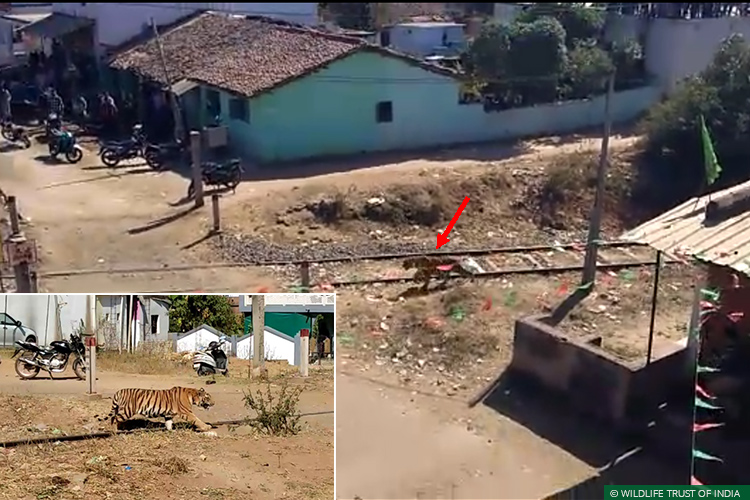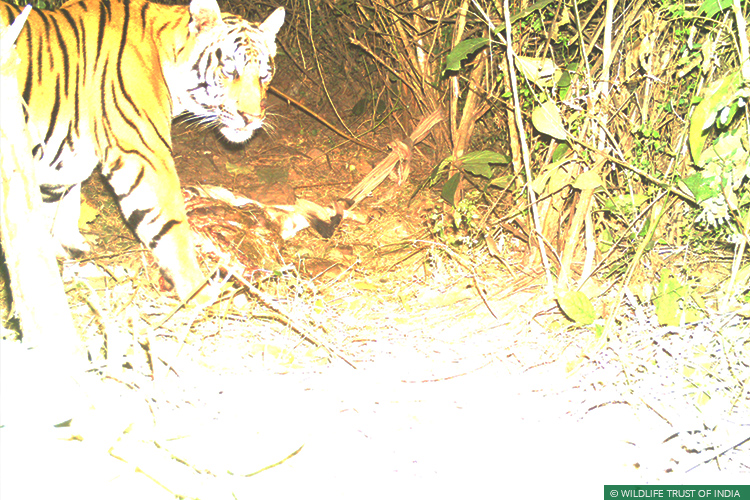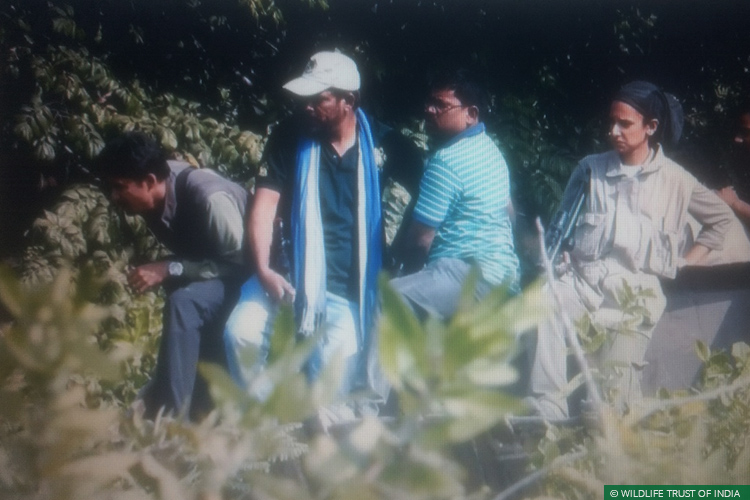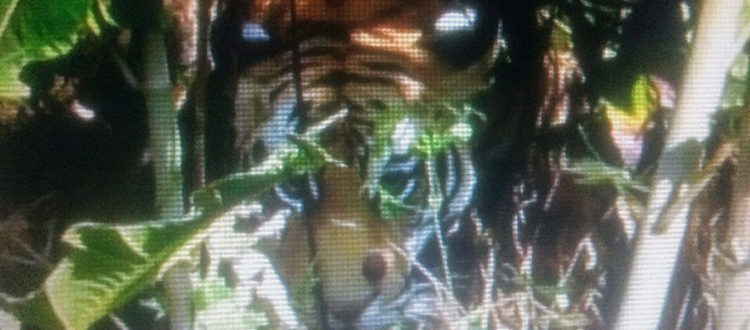The Unexpected Guest: When a Tiger Visited a Village in Tumsar
On December 22, 2017, members of the Rapid Response Team (RRT) of Wildlife Trust of India’s Vidarbha Tiger Project – run in partnership with the Maharashtra Forest Department and the International Union for Conservation of Nature (IUCN) – assisted Forest Department and Special Tiger Protection Force (STPF) personnel in tranquilising and capturing a male tiger that ventured into a village in the Tumsar region of Vidarbha. The following is a from-the-ground account of the operation.

Video grab of the tiger (red arrow and inset) walking through the village along a railway line.
December 18, 2017 will be a day forever etched in the memory of the villagers of Sita Saongi, located in the Tumsar region of the Bhandara District in Vidarbha, Maharashtra. A village like any other in the Vidarbha region, Sita Saongi abuts small but dense scrub forest patches amidst a plethora of large-scale anthropogenic alterations, such as roadways, railway lines and a sprawl of concrete structures. Perhaps the only wild animals the people of this area are attuned to seeing are the occasional wild pigs scurrying rapidly away from human eyes.
On this day, however, a creature that most people in the area had only heard of or seen in zoos decided to pay them a visit. In the wee morning hours, a full grown male tiger (Panthera tigris tigris) emerged out of “almost nowhere” and decided to take a stroll around the village – from the market to the local bus stop to the railway track that passes though the village.
A six-hour-long free roadshow followed for the crowd of over a thousand people that had gathered. Many captured the moment on their cell phones, and videos of the spectacle went viral in a matter of minutes. This led to the amassing of even larger numbers of people from nearby villages to catch a glimpse of the tiger.
Although the tiger seemed to be fairly comfortable with human proximity, it was clearly not enjoying the mass attention. It appeared to be frantically seeking a way out of the mayhem, which it finally found, taking refuge in a small but dense scrub patch of around 34 hectares. With sufficient cover at its disposal it also managed to grab an unsuspecting goat for its meal. Locals later said that the remains of a wild pig and another goat had been found a few days prior, though no one had suspected the predator to be a tiger at the time.
 A camera trap image of the tiger, from one of the cameras deployed by the RRT to determine its location and movement patterns
A camera trap image of the tiger, from one of the cameras deployed by the RRT to determine its location and movement patterns
The tiger’s presence in the village galvanised the local forest department into action, and formal permission to tranquilise the animal and remove it from the area was sought from the Chief Wildlife Warden of Maharashtra. An attack on a human being could not be risked; immediate remedial action was required. WTI’s Rapid Response Team (RRT; an all-encompassing conflict mitigation unit with veterinary, biological and sociological skill sets and vital immobilisation and capture equipment), placed at Bhandara under a joint initiative with the Maharashtra Forest Department and IUCN, was called in to assist in the operation.
On reaching the spot, RRT members swung into action with members of the Maharashtra Forest Department, the STPF, and members of another on-ground conservation partner organisation named Save Ecosystem and Tiger (SEAT). Intensive scouting operations initially failed to reveal the tiger’s exact location, although the team narrowed the search to a patch of scrub forest where it was probably taking refuge.
As RRT personnel ventured into the thickets to check the camera traps, they sighted the tiger – dangerously close, forcing them to beat a hasty retreat.
On December 21, the tiger was briefly sighted by some local youth and on-ground personnel redoubled their efforts to locate the animal. Pugmarks from a half-eaten goat kill were tracked, reports of authentic sightings by locals were sought, and camera traps were strategically placed over the course of the day. The next day as RRT personnel ventured into the thickets to check the camera traps, they sighted the tiger – dangerously close, forcing them to beat a hasty retreat. They now had a confirmed location for the animal within the scrub forest, however, so a systematic capture attempt could be orchestrated. The RRT’s sociologists, along with Mr Shahid Khan from SEAT, STPF personnel and forest staff sought to bring some order to the thousands of unruly people that had gathered around the area. Meanwhile, the veterinarians and biologists began preparing for the tiger’s chemical immobilisation and capture.
Since venturing into the scrub patch on foot would have imposed an unreasonable level of risk, two JCB earthmover machines were called in. RRT veterinarian Dr Disha Sharma, along with other RRT members and forest officials, were hoisted up using the machines and slowly approached the tiger, which was resting in the scrub thickets.
At the first opportunity Dr Sharma and an STPF official delivered three doses of sedative that safely immobilised the tiger. It was quickly wrapped in nylon nets and moved into a capture crate, and then onto a completely covered rescue van which was used to transport it to the Gorewada Rescue Centre near Nagpur.
An initial medical examination by RRT veterinarians found it to be a healthy male, approximately 4-5 years old, without any sort of infirmity – all canines and claws intact, no structural deformities or disabling wounds, except for a single large wart on the left side of its nose. The tiger is currently housed at the Gorewada Centre and awaits further examination, particularly of the wart, before a decision to release it back into the wild can be taken by the forest department.
WTI Rapid Response Team members who participated in the operation: Anil Nair, Nikhil Dandekar, Dr Disha Sharma, Dr Sayyed Bilal, Mahendra Raut, Jitendra Katare and Ahmad Pathan.
 RRT team members and forest officials atop one of the JCBs. Dr Disha Sharma, who tranquilised the tiger, is at the far right
RRT team members and forest officials atop one of the JCBs. Dr Disha Sharma, who tranquilised the tiger, is at the far right









